
Saxifraga is the largest genus in the family Saxifragaceae, containing about 440 species of holarctic perennial plants, known as saxifrages or rockfoils. The Latin word saxifraga means literally "stone-breaker", from Latin saxum + frangere. It is usually thought to indicate a medicinal use for treatment of urinary calculi, rather than breaking rocks apart.

Micranthes hieraciifolia is a species of flowering plants. It is native to Europe, North America and temperate Asia, being distributed throughout the high Arctic and some alpine areas like Norway and the Carpathian Mountains, with a few isolated populations in the Central Eastern Alps of Austria and the Massif Central of France. It is generally uncommon.

Micranthes nivalis is a plant species in the saxifrage family. It is commonly called snow saxifrage or (ambiguously) alpine saxifrage.
Alpine saxifrage is a common name for several different plants and may refer to:

Micranthes aprica is a species of flowering plant known by the common name Sierra saxifrage. It is native to the high mountains of California, including the Sierra Nevada and the southern Cascade Range, and adjacent slopes in southern Oregon and western Nevada. It grows in mountain habitat in areas of alpine climate, such as meadows and next to streams of snowmelt. It is a perennial herb which spends most of the year in a dormant state in order to save water, and rarely flowers. It produces a small gray-green basal rosette of toothed oval leaves up to about 4 centimeters long. When it does bloom, it sends up an erect inflorescence on a peduncle several centimeters tall topped with a cluster of flowers. Each flower has five sepals, five small white petals, and a clump of whiskery stamens at the center.
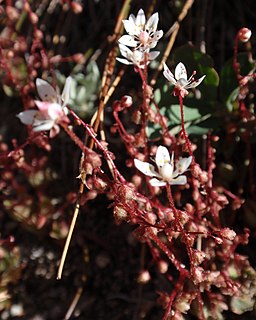
Micranthes bryophora is a species of flowering plant known by the common name bud saxifrage. It is native to the western United States, where its two varieties are geographically separated. The more common var. bryophora is endemic to the mountains of California, and the rare var. tobiasiae is known only from the Payette National Forest of western Idaho.

Micranthes ferruginea is a species of flowering plant known by the common names russethair saxifrage and rusty saxifrage. It is native to western North America from Alaska and northwestern Canada to northern California to Wyoming, where it can be found in moist, rocky habitat in mountainous areas. It is a perennial herb growing from a caudex and rhizome system and producing a basal rosette of leaves. Each leaf is up to 6 centimeters long, thick and fleshy with large teeth along the edges. The inflorescence arises on a slender, hairy peduncle up to 40 centimeters tall. Thin branches bear flowers and reproductive bulbils. Each flower has spade-shaped white petals, the upper ones dotted with gold.

Micranthes integrifolia is a species of flowering plant known by the common name wholeleaf saxifrage. It is native to western North America from British Columbia to Montana and northern California, where it grows in moist habitat, including meadows, prairies, and grassy mountain slopes. It is a perennial herb growing from a caudex and system of rhizomes, and producing a basal rosette of leaves. Each leaf is up to 7 centimeters long with a toothed or smooth-edged blade borne on a short petiole. The inflorescence arises on a stout, hairy peduncle up to 35 centimeters tall. White-petaled flowers occur in a cluster or dense array at the top.
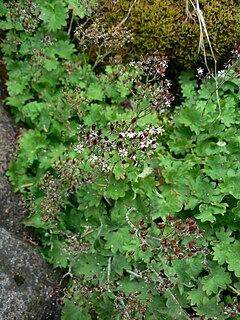
Micranthes odontoloma is a species of flowering plant known by the common name brook saxifrage. It is native to much of western North America, where it can be found in many types of moist and rocky habitat types. It is a perennial herb growing from a caudex and rhizome system. It produces a clump of leaves with rounded, toothed, or scalloped blades on long, thin petioles. The branching inflorescence arises on a slender, erect peduncle up to half a meter tall bearing many flowers. Each flower has five teardrop-shaped white petals with threadlike bases, and stamens with flat, narrow filaments that sometimes resemble additional petals.
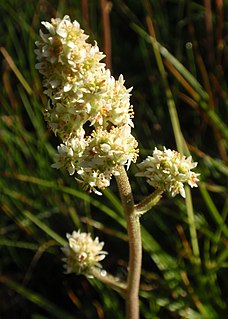
Micranthes oregana is a species of flowering plant known by the common name Oregon saxifrage. It is native to western North America, including the mountainous regions of the western United States. It can be found in moist habitat, such as marshes and other wetlands. It is a perennial herb growing from a thick, fleshy or woody caudex. It produces a basal rosette of linear to lance-shaped leaves each up to 25 centimeters long. The inflorescence arises on a stout peduncle which may exceed a meter in height. It is topped with one or more dense clusters of white-petaled flowers.

Micranthes rufidula is a species of flowering plant known by the common name rustyhair saxifrage. It is native to western North America from British Columbia to Oregon, and one location in northern California. It grows in moist, open and rocky habitat in mountainous areas. It is a perennial herb growing from a small caudex and system of rhizomes. The leaves have oval blades lined with blunt teeth borne on long petioles. The inflorescence arises on a hairy peduncle, the flowers bearing white petals.

Micranthes tolmiei is a species of flowering plant known by the common name Tolmie's saxifrage, or Tolmie's alpine saxifrage. It is native to western North America from Alaska to Montana to California, where it grows in rocky mountain habitat types, especially in alpine climates, such as talus and fellfields. It is a small perennial herb growing in mats of creeping stems lined with thick, fleshy leaves each up to 1.5 centimeters long. The inflorescence arises on a stout, erect peduncle with a few stubby bracts midway up. The flowers have narrow white petals and petal-like white stamens.
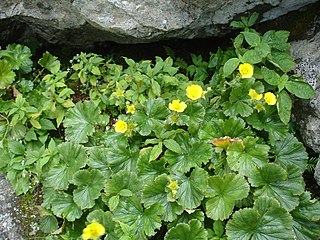
Geum radiatum is a rare species of flowering plant in the rose family known by the common names spreading avens, Appalachian avens, and cliff avens. It is native to the region of the border between Tennessee and North Carolina in the southeastern United States, where there are eleven known populations remaining. The plant was federally listed as an endangered species in 1990.

Micranthes micranthidifolia is a member of the Saxifrage family with the common names lettuceleaf saxifrage, branch lettuce and brook lettuce. It grows in wet areas and mountain streams.

Boykinia aconitifolia, also known as Brook saxifrage and Allegheny brookfoam, is a species of vascular plant in the genus Boykinia. It is native to the southeastern region of the United States, ranging from West Virginia to Alabama and Georgia. It grows in wet woodlands, on the edges of ponds and lakes, or in other moist areas, flowering in the summer. It has both basal and cauline leaves, with petioles three to eighteen centimeters long. Leaves are generally reniform, but can be orbiculate to cordate with three to seven lobes. The seeds are black with tubercles.
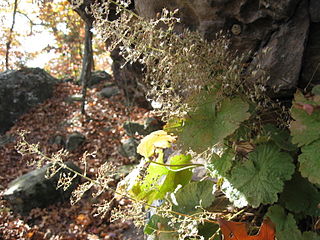
Heuchera parviflora is a species of flowering plant in the saxifrage family known by the common names cave alumroot and littleflower alumroot. It is native to the eastern United States, where it is found primarily in the Ozark Mountains, Appalachian Mountains, and Cumberland Plateau. It is found in deeply shaded areas such as under rock overhangs and cliffs, almost always where no direct sunlight falls. In this habitat, it is often the only vascular plant found. H. parviflora is an uncommon species throughout its range. It flowers in late summer through fall.

Micranthes californica, known by the common name California saxifrage, is a species of flowering plants.
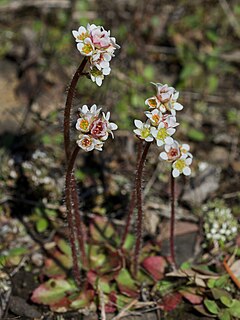
Micranthes texana, commonly called Texas saxifrage, is a species of plant in the saxifrage family that is native to Texas, Oklahoma, Arkansas, Missouri, Louisiana and Nebraska with a disjunct occurrence in Georgia.
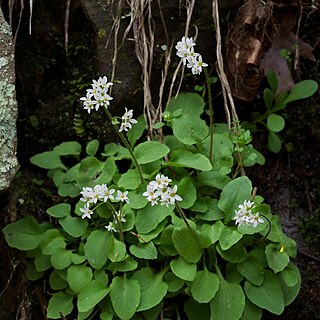
Micranthes palmeri, commonly called Palmer's saxifrage, is a species of plant in the saxifrage family that is native to Oklahoma and Arkansas in the United States.
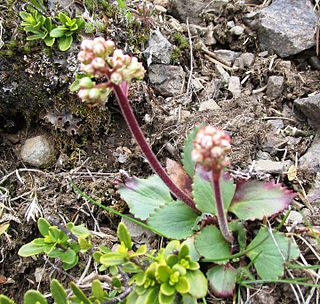
Micranthes occidentalis, commonly known as western saxifrage, is a species of flowering plant native to North America..



















